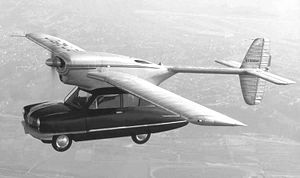Convair Model 118 ConvAirCar Video - Picture

|
|
Convair Model 118 ConvAirCar

Picture - Company photograph taken over San Diego, California, USA, November 1947, photographer: Ben Ross
Role: Flying car
National origin: United States of America
Manufacturer: Convair
Designed by: Ted Hall
First flight: November 1, 1947 (Model 116: 1946)
Number built: 2
Unit cost: $1,500
Developed from: Convair Model 116
The Convair Model 118 ConvAirCar was a prototype flying car of which two were built. Intended for mainstream consumers, two prototypes were built and flown. The first prototype was lost after a safe, but damaging low fuel incident; consequently, the second prototype was rebuilt from the damaged aircraft, and flown although little enthusiasm remained for the project and the program ended shortly after.
Design and development
Consolidated Vultee Aircraft (later Convair) was seeking entry into the post-war aviation boom with a mainstream flying car. Theodore P. "Ted" Hall had studied the concept of a flying car before World War II, with Consolidated unsuccessfully proposing the idea for use in Commando type raids. Following the end of the War, Hall and Tommy Thompson designed and developed the Convair Model 116 Flying Car featured in Popular Mechanics magazine in 1946, which consisted of a two-seat car body, powered by a rear mounted 26 hp (19 kW) engine, with detachable monoplane wings and tail, fitted with their own tractor configuration 90 hp (67 kW) Franklin 4A4 engine driving a two bladed wooden propeller. This flew on July 12, 1946, completing 66 test flights.
Hall subsequently designed a more sophisticated development of the Model 116, with a more refined car body and a more powerful "flight" engine. A 25 hp (19 kW) Crosley engine was in the rear, powering the plastic-bodied 4-seat car and a 190 hp (142 kW) Lycoming O-435C was used for the powerplant of the aircraft. A lofty production target of 160,000 was planned, with a projected $1,500 price tag. Convair anticipated that the Model 118 would be purchased in large numbers to be rented at airports.
Operational history
Test pilot Reuben Snodgrass flew the prototype, registered NX90850 for the first time on November 15, 1947 but it made a low fuel forced landing near San Diego, California on November 18, 1947, while on a one-hour demonstration flight, destroying the car body and damaging the wing, although the pilot escaped with minor injuries. The pilot reputedly took off with little or no aviation fuel aboard although the fuel gauge he was looking at showed full fuel, but it was the automobile fuel gauge. Using the same wing and another car body, the second prototype flew again on January 29, 1948 piloted by W.G. Griswold, but enthusiasm for the project waned and Convair cancelled the program. The rights reverted to Hall, who formed T.R Hall Engineering Corp., but the Model 118 in its new incarnation never achieved production status.
Specifications (Model 118)
Data from General Dynamics Aircraft and their Predecessors
General characteristics
Wingspan: 34 ft 5 in (10.49 m)
Height: 8 ft 4 in (2.54 m)
Empty weight: 1,524 lb (691 kg)
Gross weight: 2,550 lb (1,157 kg)
Powerplant: 1 x— Lycoming O-435C air-cooled flat-six, 190 hp (140 kW)
Powerplant: 1 x— Crosley air-cooled, 25 hp (19 kW) (powered the car body)
Performance
Cruise speed: 125 mph (109 kn; 201 km/h)
Flying car (aircraft)
Comparable aircraft
Aerocar
Aerocar 2000
Parajet Skycar
Transition (roadable aircraft)
Bibliography
Wegg, John. General Dynamics Aircraft and their Predecessors. London: Putnam, 1990. ISBN 0-85177-833-X.
Yenne, Bill. The World's Worst Aircraft. New York: Dorset Press, 1993. ISBN 0-88029-490-6.
Living Warbirds: The best warbirds DVD series.
Source: WikiPedia